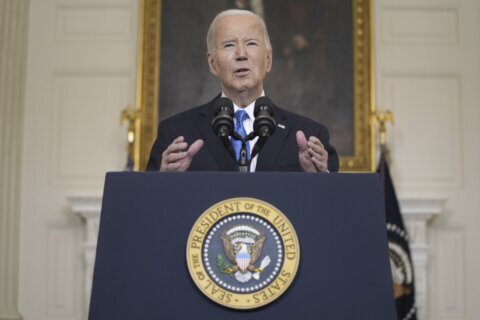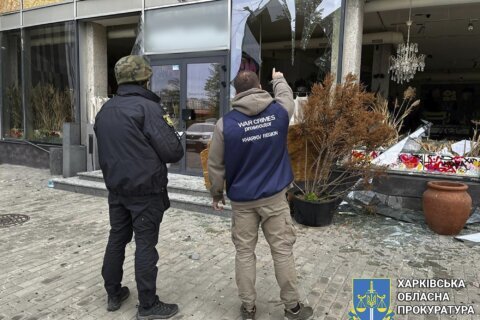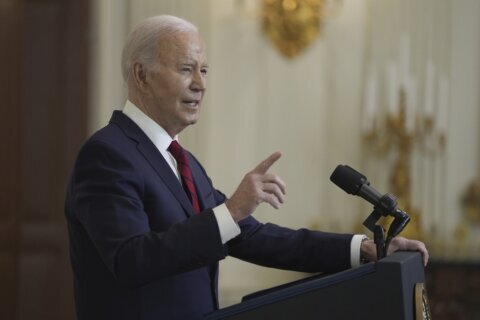The battle for Ukraine’s strategic port of Mariupol raged on Monday, as Ukraine rejected a Russian offer to evacuate its troops from the besieged city. Russian bombardment continued to hit it and other cities in Ukraine.
Ukrainian President Volodymyr Zelenskyy said about 400 civilians were taking shelter at an art school in the Sea of Azov port city when it was struck by a Russian bomb.
Warning that relations with the U.S. are “on the verge of a breach,” Russia has summoned the U.S. ambassador to protest President Joe Biden’s criticism of Russian President Vladimir Putin.
Russia’s war in Ukraine, now in its 26th day, shows no signs of abating. The invasion has wreaked devastation, exacting a heavy toll on civilians. The U.N. says nearly 3.4 million people have fled Ukraine.
Here are some key things to know about the conflict:
WHAT IS THE LATEST IN MARIUPOL?
The key port city has seen some of the heaviest fighting since the Russian invasion. Russian and Ukrainian soldiers are fighting block-by-block for control of the city where at least 2,300 people have died, some buried in mass graves.
Ukrainian forces had destroyed a Russian patrol boat and electronic warfare complex, the Defense Ministry said.
Ukrainian officials rejected a Russian offer that its troops be granted safe passage out of the encircled city, which would hand Mariupol over to Russia, uniting Russian forces in southern and eastern Ukraine along the Sea of Azov.
It was not clear how many casualties there were in the Russian bombing of the art school, Zelenskyy said in a video address early Monday. That attack came just days after a bomb hit a theater Wednesday in Mariupol where more than 1,000 people were believed to be sheltering. It was unclear how many people were killed in that attack.
“Almost 90% (of the city) has been destroyed,” Mariupol resident Maria Fiodorova, 77, said Monday as she crossed the border into Medyka, Poland. “There are no buildings there anymore.”
The Ukrainian government said that about 3,000 people from Mariupol were evacuated on Monday.
WHAT IS HAPPENING ELSEWHERE IN UKRAINE?
In a video address, Zelenskyy hailed protesters in the occupied city of Kherson for courage in confronting Russian troops who used stun grenades and fired in the air to break up a demonstration.
Zelenskyy said that the war has turned ordinary Ukrainians into heroes and “the enemy doesn’t believe it’s all real.”
Zelenskyy said in his nighttime video address to the nation that Russian forces shelled along a humanitarian corridor on Monday, wounding four children who were among the civilians being evacuated.
He said the shelling took place in the Zaporizhzhia region, the initial destination of those fleeing Mariupol.
The Ukrainian army announced that it forced Russian troops out of a strategically important Kyiv suburb after a fierce battle. By taking Makariv, located 55 kilometers (33 miles) west of the capital, the Ukrainian forces deprived Russia of control over an important highway and prevented it from encircling Kyiv from the northwest, the Defense Ministry said on Tuesday.
However, Russian forces were partially able to take three northwest suburbs where there has been fighting for weeks, the ministry said.
Meanwhile, the Russian military says it will keep using state-of-the-art hypersonic Kinzhal missiles to hit particularly important targets in Ukraine.
Russian shelling on Sunday near the city center of the capital, Kyiv, killed eight people, according to emergency officials. The attack damaged a nearby high-rise building and devastated a shopping center, which Russian Defense Ministry spokesman Maj. Gen. Igor Konashenkov said had been targeted because it was used to store rockets. The claim couldn’t be independently verified.
Ukraine’s prosecutor general said a Russian shell struck a chemical plant outside the city of Sumy, causing a leak in a 50-ton tank of ammonia that took hours to contain.
Konashenkov also said an overnight cruise missile hit a Ukrainian military training center in the Rivne region, killing 80 foreign and Ukrainian troops.
Ukraine’s nuclear regulatory agency said Monday the radiation monitors around the Chernobyl nuclear power plant — site of the world’s worst meltdown in 1986 — have stopped working.
WHAT HAS THE AP DIRECTLY WITNESSED OR CONFIRMED?
AP video journalist Mstyslav Chernov has recounted his harrowing experience, along with AP photographer Evgeniy Maloletka, of being the only international journalists in besieged Mariupol before fleeing last week.
“We were the last journalists in Mariupol. Now there are none,” he said.
The Russian siege of Mariupol has caused shortages of food, water and energy supplies. Video captured by AP shows residents pushing carts and carrying bags of food and supplies along debris-ridden streets and passages.
AP journalists on the scene of Russian shelling in Kyiv witnessed the flattened ruin of the shopping center, which was still smoldering Monday morning. The force of the explosion shattered every window in the high-rise next door and twisted its metal frames. In the distance, the sound of artillery rang out as firefighters picked their way through the destruction in the densely populated Podil district.
ARE RUSSIAN FORCES MAKING ANY ADVANCES?
Russians have increased the number of military aircraft sorties over Ukraine over the past two days, according to a senior U.S. defense official speaking on condition of anonymity to discuss the military’s assessment. That reportedly includes as many as 300 in the last 24 hours, most of which involve air-to-ground strikes. As of Monday, Russia had launched more than 1,100 missiles into Ukraine, the official said.
The official said Monday that Ukraine — which is using short and long-range air defense systems and drones to target Russian aircraft — has also increased the pace of its military flights, but declined to provide numbers.
Denied an early victory, Russia’s military is reverting to the scorched earth tactics of its past offensives in Syria and Chechnya, and pounding cities with airstrikes and artillery barrages.
WHAT ABOUT DIPLOMATIC EFFORTS SURROUNDING THE CONFLICT?
Talks between Russia and Ukraine have continued by video but failed to bridge the chasm between the two sides, with the Kremlin demanding Ukraine disarm and declare itself neutral. Zelenskyy told Ukrainian television late Monday he would be prepared to consider waiving any NATO bid by Ukraine in exchange for a cease-fire, the withdrawal of Russian troops and a guarantee of Ukraine’s security.
Zelenskyy has recently begun suggesting Kyiv would be open to future discussions on the status of Crimea, which Russia seized in 2014, and the regions of the eastern Donbas region held by Russian-backed separatists. But he said that was a topic for another time, after a cease-fire and steps toward security guarantees.
Biden travels to Europe this week, where he will attend a summit with NATO leaders that will look for ways to strengthen the bloc’s own deterrence and defense to deal with the now openly confrontational Putin. Citing “unacceptable statements” by Biden about Putin — an apparent reference to the American calling the Russian a “war criminal” — the Russian Foreign Ministry has warned that relations with the U.S. are “on the verge of a breach” and summoned the U.S. ambassador.
According to the White House, Biden and the leaders of France, Germany, Italy and the UK discussed the war Monday, including concerns about Russia’s tactics in Ukraine, attacks on civilians, and underscored continued humanitarian and security support for Ukraine.
Biden has added a stop to Poland during his trip, visiting a crucial ally of Ukraine which has taken in more than 2 million Ukrainian refugees.
Biden warned U.S. companies that Russia could be preparing to launch cyberattacks against critical infrastructure.
France and Mexico are pressing U.N. members to mention Russia’s invasion in a resolution on the worsening humanitarian situation in Ukraine. But South Africa is arguing against that approach, saying that inserting political issues may block consensus on helping civilians.
HOW MANY CIVILIANS HAVE DIED IN UKRAINE?
Comprehensive casualty figures are difficult to confirm. From the start of the war through Sunday, the U.N. human rights office recorded 925 civilians killed and 1,496 injured. Ukrainian officials say thousands of civilians have been killed. Estimates of Russian deaths vary, but even conservative figures are in the low thousands.
Mariupol officials said on March 15 that at least 2,300 people had died in the siege, with some buried in mass graves. There has been no official estimate since then.
___
Follow the AP’s coverage of the war between Russia and Ukraine: http://apnews.com/hub/russia-ukraine
Copyright © 2024 The Associated Press. All rights reserved. This material may not be published, broadcast, written or redistributed.







